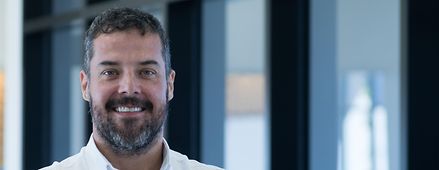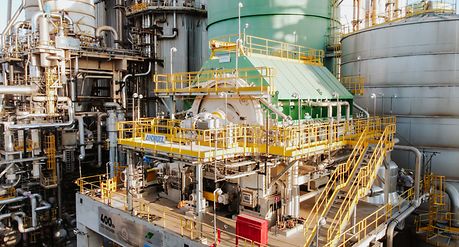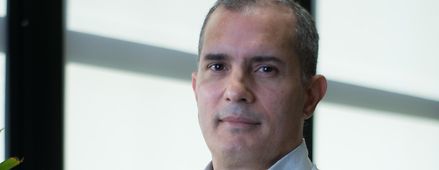“Klabin’s relationship with the local communities is transparent, very close, and goes beyond employment of the workers.”
João Braga
Klabin’s Director of Projects and Engineering
So, how do you like your pulp, paper or board: Hardwood or softwood? Eucalyptus or pine? Bleached or unbleached? Would you like brown or white Kraftliner? And would you like Topliner with that? Would you like carrier board, folding box board, or liquid packaging board? And would you like to add a biodegradable coating to your board? How about the 100% eucalyptus Eukaliner range that is taking the world by storm? Or would you prefer something from our fluff range?
The choices of grade and qualities of pulp, paper, and board being produced at the Puma mill appear to go on endlessly, being self-sufficient and exporting power to the grid, using biomass as solid, liquid or gas as fuels and producing sulphuric acid, tall oil, turpentine, methanol, and potassium. And as an extra bonus the Puma operation can switch easily and quickly to any grade that the current market demands. With a total capacity of 2.5 million tonnes of pulp, paper, and board, this mill in southern Brazil is now an exhibition in pulp and papermaking. In fact, Klabin’s Project and Technology Manager, Rodrigo Vendramini, goes even further, “This is a Disneyland for pulp and paper makers; we basically have everything here a pulp or paper maker could ever dream of and make whatever they want.”
João Braga
Klabin’s Director of Projects and Engineering
In terms of raw material, Klabin has some 234,000 ha of wood planted in Paraná state alone, with 40% of the land given over to biodiversity. João Braga, Klabin's Director of Projects and Engineering, says, “Our conservation strategy is recognized the world over as an excellent sustainability model." Braga continues, “The target here is to have at least 80% of our wood coming from our own, sustainably managed plantations.
“For this project, we had to build the inward and outward logistics for the development, including roads and a rail head. It was an enormous operation, and now our development in Paraná state is considered to be one of the largest forest products operations in the world.”
Klabin is a huge and important employer in the region, with some 6,000 employees in Paraná state when forestry operations and the nearby Monte Alegre and Puma mills are considered. "Klabin's relationship with the local communities is transparent, very close and goes beyond employment the of workers,” continues Braga. “Bringing economical health to the area is one of the main pillars in our operational strategy, which generates important benefits, including helping the local cities with administration support from specialists and helping young people when it comes to improving their education.
Klabin's operations in the area see a lot of truck movements everyday transporting around 14 million tons of wood a year. “This is why we have built an impressive logistic hub, including the containers terminal connected to the port,” says Braga. “From here our final products go out to the main local port by rail, and then out to the 60 countries around the world to whom we export our products.
“The rail terminal takes trucks off the road and reduces emissions as well as costs.”
The focus on environmental excellence extends across the board at Klabin, from forestry operations right down to the final product, which is why this was an important issue when it came to the Puma II project at the mill.
After the successful results working with ANDRITZ on the Puma I project at the mill, which included the installation of the woodyard, four complete debarking and chipping lines, two cooking plants and fiber lines for bleached pulp grades for hardwood and softwood, two lime kilns, and a white liquor plant, Klabin embarked on the Puma II project that has included several major deliveries and upgrades from ANDRITZ, as well as adding two of the latest paper machines to the site, thus maximizing the potential of an integrated pulp and paper mill.
“It’s all about trust and cooperation,” says Rafael Sirtoli, Director of Operations, ANDRITZ. “The Puma I project went even better than the original plan. We were even ready for the start-up some days before the contractual date in some areas. The Puma I project also included a hardwood and a softwood bleached kraft pulp line with the challenge of building both lines in parallel. The ANDRITZ team did a great job on the cooking and washing concept, and the project was carried out smoothly. We were all very happy with how the Puma I project went.”
Puma II project phase 1, was focused on supplying brown pulp to Klabin’s new paper machine 27, which is producing the company’s new revolutionary Eukaliner, a Kraftliner made from 100% eucalyptus. For this part of the project, ANDRITZ supplied a wood processing line, HERB recovery boiler, EcoFluid power boiler, and a complete white liquor plant consisting of a recausticizing plant and lime kiln. ANDRITZ also supplied a gasification plant and SulfoLoop sulfuric acid plant.
The Puma II project also meant that a major expansion program was needed to increase capacity of the Puma I bleached fiberlines in two different phases; first, comprising a capacity increase of the cooking plants and second, a capacity increase of the hardwood line, from 3,742 adt/d to 4,080 adt/d. ANDRITZ once more was chosen as the main supplier to provide the very latest environmentally leading technology for the capacity increase. The scope of supply included the modernization of the cooking, washing, screening, and bleaching processes including the delivery of the 400th ANDRITZ DD-Washer to ensure the production of high-quality pulp, maximum operating availabilty, and low chemical consumption.
Great portion of the capacity increase was done during the annual maintenance shutdown, of the mill “This was the most challenging modification ever,” says Vendramini. “It was amazing the amount of work done by ANDRITZ and Klabin teams to increase the capacity of the line by 340 t/d. During a 10-day shutdown there were some 50 tons of piping to be replaced as well as many motors and pumps to be changed/repowered. This period was a hive of activity on the hardwood line, ending up with a great result, on schedule, with safety and quality.
“We were delighted to receive the 400th DD-Washer that ANDRITZ has produced,” says Vendramini. “We also have the 300th one on our Puma I line. The washer capabilities are very familiar to us especially in its flexibility for higher production rates and low chemical consumption in bleaching.”
The scope of the second phase also included a debarking and chipping line, making it the sixth wood processing line from ANDRITZ installed at the mill. The complete wood processing plant includes six ANDRITZ debarking drums and six EXL-size HHQ-Chippers, one for each line.
ANDRITZ also supplied leading environmental technology for renewable and recyclable technology with its SulfoLoop sulfuric acid plant and gasification technology for one of the Puma I lime kilns.
“Along with its proven technology in the woodyard, pulping, and recovery processes, we also chose ANDRITZ because we want to be environmentally responsible,” says Braga. “This is why we decided to invest in the new technology of SulfoLoop and gasification of the new lime kiln.
“Sustainability is another one of the pillars of our strategies at Klabin; the reuse of raw materials, saving of fossil fuels, and reducing GHC emissions fits firmly into our strategy.”
ANDRITZ gasification plant for the lime kiln
Rodrigo Vendramini
Klabin's Project and Technology Manager
“The Puma II project kicked off in May 2019 and was going really well, with all the plants we were working better than the schedule,” says Vendramini. “And then came the pandemic!
“This was obviously a major challenge. We suddenly had to shut down the site construction and installation activities of the project, and somehow demobilize the 6,000 people we had on site and move them back home under the governmental conditions of the pandemic. As everybody else, we had no experience like that before and, of course, the safety of our people and those working on the project was of paramount importance. We then had to figure out how we could continue the project under these adverse conditions. Remobilizing the workers took long, following strict protocols set by authorities, Klabin, and ANDRITZ.”
This turned out to be a real test of the relationship between Klabin and ANDRITZ, as this was not just a question of health and safety. There was also a major project to continue with all the attendant challenges of equipment deliveries held up in ports and ongoing construction activities with a severely depleted work force due to the raging pandemic.
Sirtoli says, “This was a difficult time, and there were some major headaches due to equipment delays with ports being shut.
There were also challenges on the ground; for example, there were days when as many as 100 construction workers didn’t turn up due to positive COVID tests.
“But it has to be said, the cooperation with Klabin was brilliant, the lines of communication were fully open, and the company was very empathetic to our needs and challenges. At this stage we had weekly meetings where the project leaders from both sides covered all the eventualities that were affecting the project and found solutions that worked for both parties.
“This was a difficult phase we went through, but we were really strong together,” adds Vendramini. “And with open and transparent communication we all understood very well the challenges both parties were facing, which enabled us to move forward in a decisive way.”
As well as dealing with COVID-19 as the project got back on track, there were still major challenges, including the first capacity increase of the cooking plants during the maintenance shutdown of the mill.
“In the end, the whole project had gone under replanning and deviated for some weeks from the original schedule, which was impressive considering the impact COVID had,” says Vendramini.
Francisco Razzolini
Klabin’s Director of Industrial Technology
Innovations and Sustainability
After the start-up of ANDRITZ pulping technology and two paper machines, PM27 (which started up in 2021) and PM28, the Puma mill is now producing some of the most varied ranges of paper and board seen at any mill around the world. PM28 started up in late June 2023 and is now adding value to the mill’s output by satisfying numerous customers from specialist liquid packaging grades to 100% Eukaliner for corrugated packaging, and almost every grade in between.
But the work doesn't stop. Ricardo Cardoso, Industrial Director of Klabin Puma Mill, says, "We are very pleased with how ANDRITZ supported us in the Puma II project. Through a close collaboration between the Klabin team and our suppliers, we are now fully equipped to provide sustainable solutions, encompassing all sorts of paper and cardboard types and varieties that our clients require to enhance their business success.
"With all the efforts we have made to streamline and increase capacity, along with providing various innovative technologies following the best environmental practices, we are already witnessing improvements in the capacity and quality of our paper and board production. However, it's a complex plant, and there is still work to be done to optimize the overall factory balance. It's reassuring to know that ANDRITZ is here to work with us on this journey."
The Puma mill is the result of one of those extraordinary projects in this industry in terms of its scale and depth of innovation, ingenuity, and execution. Whether its civil or equipment engineering excellence, and sheer physical effort, or intricate new innovations and environmental additions, Klabin’s Puma mill is now virtually a closed loop circular biorefinery, and a fantastic example for the pulp and paper industry and the global bioeconomy as a whole.
Braga concludes, "ANDRITZ has played an important role in the whole Puma project, both projects I and II, and we see the compnay as the forerunner in the development and supply of top, environmentally leading technology for the pulp and paper industry.”
Klabin's newest DD-Washer is ANDRITZ' 400th DD-Washer produced
Ricardo Cardoso
Industrial Director of Klabin Puma Mill
Importantly, the orders to the Puma mill from ANDRITZ also included two firsts from under the umbrella of its CircleToZero initiative; the world’s first ANDRITZ SulfoLoop sulfuric acid plant, and a gasification plant for the lime kiln, the first of its kind started up in Brazil.
Francisco Razzolini, Klabin’s Director of Industrial Technology, Innovations and Sustainability, says, “Klabin is on a long journey to reduce and eliminate the use of fossil fuels, so we are always looking for renewable, reusable, and recyclable solutions in our operations.
“The technology for SulfoLoop and gasification of the lime kiln from ANDRITZ fits in well with our own ambitions to improve environmental performance and reduce our carbon footprint. We have always thrown out challenges to our suppliers and we are always keen to challenge them to come up with these types of solutions.”
Klabin successfully started up the SulfoLoop plant at the Puma mill in the second half of 2022. The plant has the capacity to produce 150 tons of commercial grade sulfuric acid from concentrated odorous gases and elemental sulfur. The plant serves the whole pulp and paper mill and makes the site completely self-sufficient in sulfuric acid by recycling sulfur from the waste streams.
“Despite some expected challenges as it’s a world’s first, we are now producing 98% concentrated sulfuric acid in the SulfoLoop plant, which means we no longer have to buy from the market,” says Razzolini. “This has also saved us fossil fuel emissions as we no longer need to use trucks to transport sulfuric acid to the mill.”
The gasification plant was also started up in the first half of 2022 and enables entirely fossil-fuel free operation of the lime kiln by replacing 100% of the heavy fuel oil with a biomass-derived gas.
“We are very happy with the result of this addition to the mill,” says Razzolini. “We have calculated that with this project we are reducing the use of fossil fuels by some 21,000 tonnes per year, as well as eliminating more than 60,000 tonnes of greenhouse gas emissions a year. Gasification, integrated to other renewable fuel sources, as hydrogen, tall oil, methanol, odorous gases, and turpentine, results in a very high green energy mill operation, getting closer to our ambition to zero fossil fuels."
Both projects, SulfoLoop and the gasification of the lime kiln, are part of the investments Klabin is making to reduce fossil-based emissions. “We have submitted and approved a goal with the Science Based Target Initiative (SBTi) to reduce emissions on all our operations by 25% by 2025, and 49% by 2035, based on 2020 figures," says Razzolini. “Implementing these technologies is part of that process.”
As both areas were new to Klabin’s operational team, ANDRITZ developed and delivered the first simulator, Operator Training System (OTS) for SulfoLoop and the gasification plant. The expected results with process validation, DCS logic validation, and operator training were achieved with better-than-expected results.
Leonardo Scanavini, Chemical Recovery Plant Specialist for new projects at Klabin, says, “The solutions of SulfoLoop and gasification of the lime kiln fit like a glove for us at the Puma mill. In fact, they are the 'new normal' at pulp mills now. In the future, all mills will have these types of solutions.”






